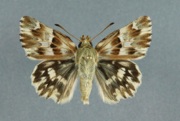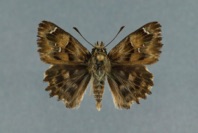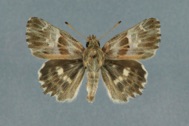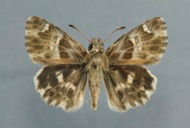Species

The genus Carcharodus Hübner, 1819 belongs to the subfamily Pyrginae of the Lepidopteran family Hesperiidae. Common characters of the genus are dentated hindwings and transparent spots on the forewings. The males of the floccifera and baeticus group have a hair tuft on the underside of the forewings. All species show geographical and seasonal variability.
The micropyle of the eggs is situated on top (exception within the Pyrginae: in C. lavatherae it is situated laterally). The caterpillars are sparsely hairy and bulky. The head is black. The larvae are brown, grey or greenish, C. lavatherae has a bright yellow lateral stripe.
Like all hesperids the caterpillars hide themselves in a leaf shelter in which also pupation occurs. The halfgrown caterpillar hibernates (exception: C. alceae hibernates fully grown). The pupa is black with a farinaceous cover wich develops during the first two days after pupation.
As a working hypothesis currently the following systematic grouping of the genus is being used (based on Hesselbarth et al. 1995 and Devyatkin 1991):
Gattung Carcharodus Hübner, 1819
Alceae group
Carcharodus alceae
(Esper, [1780])
Carcharodus tripolina
(Verity, 1925)
Lavatherae group
Carcharodus lavatherae (Esper, [1783])
Floccifera group
Carcharodus floccifera
(Zeller, 1847)
Carcharodus orientalis
Reverdin, 1913
Carcharodus dravira
(Moore, 1874)
Baeticus group
Carcharodus baeticus
(Rambur, 1839)
Carcharodus stauderi
Reverdin, 1913
Related and similar genera
Selected literature on the genus Carcharodus
Alberti, B. (1955): Zur Kenntnis der Gattung Carcharodus Hbn. (Hesperiidae) mit einer Betrachtung zum Art- und Gattungsbegriff. – Zeitschrift für Lepidopterologie, 3 (2/3): 105–142.
Devyatkin, A.L. (1991): Review of skippers of the genus Carcharodus Hbn. (Lepidoptera, Hesperiidae) of the USSR. – Entomological Review, 70 (7): 82–98.
Hesselbarth, G., H. van Oorschot & S. Wagener (1995): Die Tagfalter der Türkei unter Berücksichtigung der angrenzenden Länder. Band 1-3. – Bocholt (Selbstverlag Sigbert Wagener).
Jong, R. de (1974): Notes on the genus Carcharodus (Lepidoptera, Hesperiidae). – Zoologische Mededelingen, 48: 1–9.
Lesse, H. de (1960): Spéciation et variation chromosomique chez les Lépidoptères Rhopalocères. – Annales des sciences naturelles, douzième série. Zoologie et biologie animale, 2: 1–223.
Nel, J. (1985): Note sur la répartition, les plantes-hôtes et le cyle de développement des Pyrginae en Provence. – Alexanor, 14 (2): 51–63.
Reverdin, J.L. (1910): Carcharodus althaeae Hb. et Carcharodus baeticus Rambur. – Bulletin, Société entomologique de France, 16: 335–336.
Reverdin, J.L. (1913): Notes sur les genres Hesperia et Carcharodus. Bulletin de la Socété Lépidoptérologique de Genève, 2: 212–237.
Pro Natura (Hrsg.) (1997): Schmetterlinge und ihre Lebensräume. Arten Gefährdung Schutz. Band 2. – Egg (Fotorotar).
Sellier, R. (1972): Etude ultrastructurale en microscopie électronique à balayage et essai d’interprétation du mode de fonctionnement des poils androconiaux alaires chez les Hesperiidae (Lepidoptera Rhopalocera). – Comptes Rendus des Séances de l’Académie des Sciences, Série D, 275: 2239–2542.
Shepard, H.H. (1931–1936): Lepidopterorum Catalogus editus ab Embrik Strand. Partes 47, 64, 69 et 74. Hesperidae: Subfamilia Pyrginae. – Berlin, ‘s-Gravenhage (W. Junk).
Tshikolovets, V.V. (2011): Butterflies of Europe & the Mediterranean area. - Pardubice (Tshikolovets Pubilcations). 544 pp.
Identification
Determining the Carcharodus species can be difficult in some cases and to be certain dissection of the genitalia can be necessary. This is especially relevant for C. alceae/tripolina and the floccifera group. Also C. stauderi sometimes can only be differentiated from C. orientalis by this method. A determination key is in preparation.
Another proble is the chemically induced shifting of colours from grey/black to brown in older specimens. This cannot be avoided even by storing the material in darkness. It is clearly visible in the pictures below.
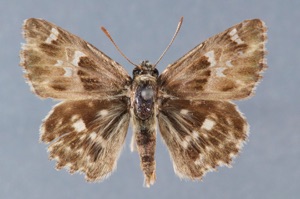

C. dravira
Fresh male (reared specimen)
Coll. Albrecht
© 2009-2020 Martin Albrecht

